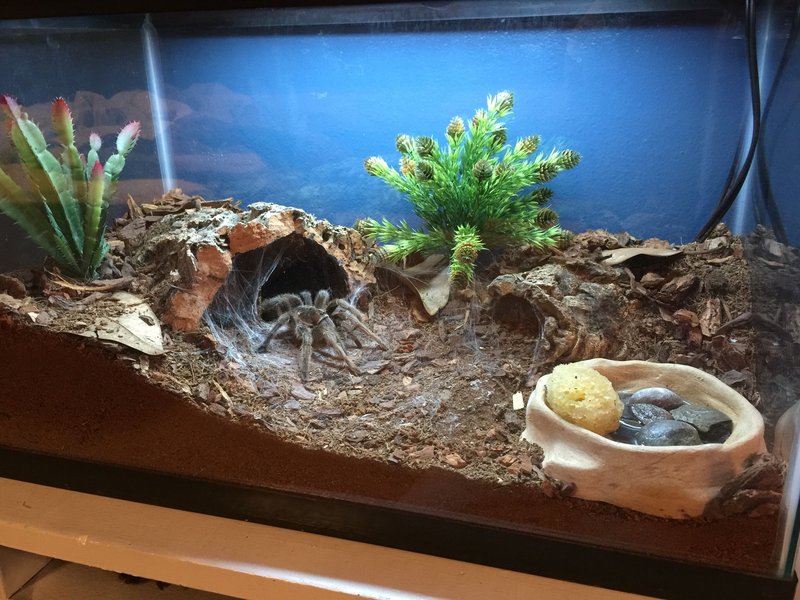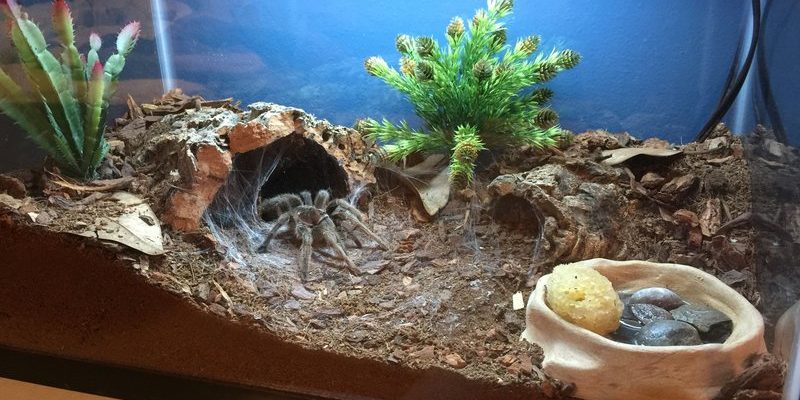
Think of the terrarium as a mini-ecosystem. Just like humans need air, water, and a comfy place to relax, your tarantula requires specific conditions in its environment to stay healthy and happy. The right setup can help regulate humidity, temperature, and even provide hiding spots for your tarantula to feel secure. Here’s the thing: getting it right can make all the difference in the world for your furry friend.
So, grab a cup of coffee, and let’s walk through the steps to build the perfect home for your Chilean Rose Tarantula.
Choosing the Right Terrarium Size
When it comes to housing your Chilean Rose Tarantula, the size of the terrarium is crucial. Generally, a 10-gallon tank is ideal for adults, while smaller enclosures work for spiderlings and juveniles. If you’re unsure, erring on the side of a larger tank can provide more space for exploration.
A good rule of thumb is to ensure there’s enough floor space for your tarantula to roam while also having vertical height for climbing. Tarantulas enjoy climbing, and providing ample height can simulate their natural habitat. Additionally, ensure that the terrarium has a secure lid. These little creatures are surprisingly good escape artists, and you don’t want a surprise tarantula roaming your living room!
When choosing the tank, consider materials like glass or acrylic. Glass is durable and easy to clean, while acrylic can be lighter and less prone to breaking. Ultimately, it comes down to your budget and preferences, but both options can work wonderfully.
Substrate: The Foundation of Your Terrarium
The substrate you choose acts like the flooring in your tarantula’s home. It’s not just about looks; it serves multiple purposes, such as helping to maintain humidity. For your Chilean Rose Tarantula, a 2-3 inch layer of substrate is perfect. You can use a mix of coconut fiber and potting soil, which not only retains moisture but also allows for burrowing.
Here’s the thing about substrates: they need to be safe. Avoid any options with added fertilizers or chemicals, as these can harm your arachnid. Make sure the substrate is also moist but not soggy; the goal is to mimic the dry environment native to Chile.
If your tarantula enjoys digging, which many do, consider adding a deeper layer in one corner to allow for more burrowing space. This simple touch can turn a standard terrarium into a thriving habitat!
Humidity and Temperature: Getting It Just Right
Maintaining the right humidity and temperature is pivotal for your Chilean Rose Tarantula’s well-being. These tarantulas thrive in relatively low humidity—generally around 40-60%—which can be achieved by lightly misting the substrate and the sides of the terrarium a couple of times a week.
For temperature, a range of 70-80°F (21-27°C) is ideal. You can use a heat mat or a lamp to keep the temperature within this range. Avoid placing heat sources directly over the tank; instead, position them on one side to create a gradient. This way, your tarantula can choose cooler or warmer areas based on its preference.
Using a reliable thermometer and hygrometer is essential here. Keeping an eye on these will help you avoid any surprises. Honestly, it’s a small investment that pays off by ensuring your tarantula stays healthy and comfortable.
Hiding Spots: Making Your Tarantula Feel Secure
Just like humans need their personal space, your tarantula will feel more secure with plenty of hiding spots in its terrarium. This is where you can get creative! You can use commercially available hiding spots like caves or logs or create your own with some natural materials.
A simple cardboard box or a half coconut shell can serve as a cozy refuge. Aim for at least two hiding spots in different areas of the terrarium. That way, your tarantula can choose where to retreat, making it feel safe and secure.
When selecting hiding spots, think about the size of your tarantula. The opening should be big enough for it to enter and exit comfortably but not so large that it feels exposed. Remember, a relaxed tarantula is a happy tarantula!
Decor: Aesthetics and Functionality
While functionality is crucial, adding some attractive elements can also make your terrarium visually appealing. Consider incorporating plants, rocks, and branches, keeping in mind your tarantula’s space needs. Fake plants work well, as live plants can sometimes require too much humidity or care that isn’t suited for your pet.
Rocks can provide climbing surfaces and look great while doing it! Just ensure they’re stable and won’t collapse if your tarantula climbs on them. Branches can also add height and create a more natural environment. You might be wondering what materials are safe—well, stick to untreated wood and rocks from pet stores or online suppliers designed for reptile habitats.
Whatever décor you choose, make sure it doesn’t crowd the tank. Your tarantula needs plenty of open space to roam, explore, and, of course, show off its beautiful legs!
Feeding Your Chilean Rose Tarantula
Now that your terrarium is set up, let’s talk about one of the most exciting parts: feeding! The Chilean Rose Tarantula primarily feeds on insects like crickets, roaches, and mealworms. It’s best to offer food that’s roughly the same size as your tarantula’s body. This helps prevent any feeding issues and ensures your pet gets enough nutrition.
Feed your tarantula around 1-2 times a week depending on its age and size. Juveniles may need food more often, while adults can go longer without eating. Keep an eye out for leftovers; if the prey isn’t consumed within a day or two, it’s a good idea to remove it to prevent stress or health issues.
You might be curious about water. A shallow bowl of water should be available at all times, but make sure it’s not too deep. Tarantulas are not great swimmers, and you don’t want an accidental drowning!
Monitoring Health and Behavior
Finally, it’s important to keep an eye on your tarantula’s health and behavior. A healthy Chilean Rose Tarantula should exhibit normal movement—slow but sure—and show interest in its surroundings. If it’s hiding more than usual or not eating, it may be a sign of stress or illness.
Make regular checks on the substrate, humidity, and temperature to ensure they remain within the right ranges. If you notice any issues, don’t hesitate to make adjustments.
Keeping your terrarium clean is also key. Spot clean any uneaten food or waste, and replace the substrate completely every few months. This not only helps maintain a hygienic environment but also ensures your tarantula stays happy and healthy.
In summary, setting up the perfect ecosystem for your Chilean Rose Tarantula is all about understanding its needs and preferences. With the right terrarium size, substrate, temperature, humidity, hiding spots, décor, and proper feeding and health monitoring, you’ll create a home where your tarantula can thrive. Enjoy the journey of being a tarantula owner; it can be a rewarding experience filled with learning and discovery!

